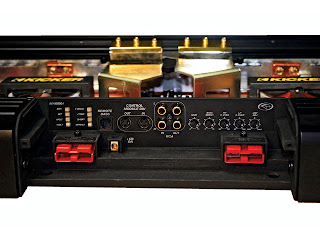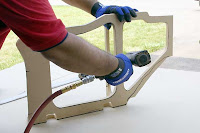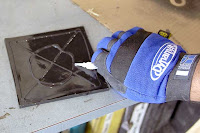With dimensions measuring 35 inches by 17 3/4 inches by 3 3/4 inches and a total weight of 66 pounds, the Warhorse is a monster of an amp. On the other hand, it's about the same size as amps with much lower power output, say, around 3,000 watts. That raises the question of
 whether it's efficient enough to actually make its claimed 10 kilowatts of power.
whether it's efficient enough to actually make its claimed 10 kilowatts of power.Before I get into it, let's look at what we're working with. Kicker has rated this beast at 10,000 watts into a 2-ohm load, or 5,000 watts into a 4-ohm load. As far as the class, it's not D, AB, or anything else you might be familiar with. In fact, the operation of this amp is so unique that Kicker has applied for a patent so they can classify it. I'll do my best to explain all that, but in the meantime study up on Class D operation and pulse width modulation as a reference point.
The amp has the usual features you'd expect to find in a big subwoofer amp like 24dB/octave highpass and lowpass crossovers, 0 to 18dB of bass boost at 40Hz, and the absence of fuses. In addition, the Warhorse sports three ought-gauge power and three ought-gauge ground cable connectors, and two pairs of 8-gauge Anderson connectors for the speaker outputs. No, it's not a stereo amp-strictly mono.
Eight indicator lights on the control panel reveal several conditions. PWR illuminates when the amp is on and working properly. NET shows that you're connected to the optional WXRC remote control, which offers expanded crossover slope selections in addition to being able to make
 adjustments from the driver seat. There are also LED indicators for over-voltage, under-voltage, overheated and short-circuit. The X-BNDW light tells you that you have set the lowpass crossover lower than the highpass crossover, while the Service light lets you know that you probably need to get the amp back to the Kicker service department or at least call the tech support line.
adjustments from the driver seat. There are also LED indicators for over-voltage, under-voltage, overheated and short-circuit. The X-BNDW light tells you that you have set the lowpass crossover lower than the highpass crossover, while the Service light lets you know that you probably need to get the amp back to the Kicker service department or at least call the tech support line.The unit looks like an oversized black briefcase with extruded fins running the length of each side. The top is an engraved black aluminum plate with a molded plastic hood over the entry for the power cables. The cast endcaps house the cooling fans and provide a very structural look to the whole unit. The power and ground-all six ought-gauge cables-come into the amp at almost the center of the top plate. All other connections and controls are hidden halfway along the nearside heat sink under a matching cover plate.
Circuitry
Looking under the cover, the first thing you'll notice is the four planar transformers and the huge buss bars that run across the topside of the main circuit board. The transformers are about the size of your hand and resemble a stack of pancakes. The primary and secondary windings are stacked on top of each other rather than being several strands of wire intertwined. The turn ratio is 19 to 1, meaning there are literally 19 turns of flat wound copper for each secondary and one turn for each primary. The primary looks more like a big horseshoe-shaped PCB trace. Each planar transformer is rated at 5,000 watts for a total capacity of 20,000 watts.
The positive and negative power cables feed the transformers directly by way of the plated copper buss bars. The B+ power supply is stabilized by a total of 50 3,300F/105 C capacitors. That makes for a lot of instant juice on tap.
The entire backside of the heat sink is occupied by 64 MOSFETs, 16 for each of the four transformers. Normally, I'd call these devices "switchers" to drive the transformers and create the positive and negative rails, but this is where we deviate substantially from every other amp. These MOSFETs do actually drive the transformers, but not at a steady rate to create a "reservoir" of output power. They actually drive the transformers directly to the speaker outputs in a pulse-width modulation fashion. This effectively eliminates the section of the amp that would normally be called the "output" section, and also eliminates the efficiency losses associated with output sections, whatever class they may be.
Let's look at the input section. The analog music signal from your head unit enters the amp by way of a pair of gold-plated RCA connectors, and goes pretty much straight to a Texas Instruments DSP chip. There's plenty of support circuitry around the DSP. In fact, the input board is about 6 inches by 8 inches, but all of the processing goes on inside the chip. The gain, crossover, bass boost, and limiter controls are all single element potentiometers that feed reference signals to the DSP chip. In other words, they have no direct effect on the analog signal; they just tell the processor what you want it to do. Once the analog signal enters the DSP, there's no more analog signal until you get to the output filter at the speaker outputs. Because the crossovers and bass boost are handled in the digital domain, the curves are picture perfect and very precise.
Here's where things get even stranger. In a typical amp you have an input stage, a power supply stage, and an output stage where the first two stages work together to kick out the tunes. The
 power supply runs at a constant rate, creating a "reservoir" of power (called "rails") that's fed to the speakers through the output transistors as the input section commands. In the Warhorse, there's an input stage as usual, but the output and power supply stages are combined. Instead of creating a reservoir of power for the output stage to use, the DSP causes the power supply to actually create the output signal directly. Instead of running at a constant level, the power supplies are constantly going up and down (signal modulated) in response to the DSP to create the output voltage. There are no output transistors.
power supply runs at a constant rate, creating a "reservoir" of power (called "rails") that's fed to the speakers through the output transistors as the input section commands. In the Warhorse, there's an input stage as usual, but the output and power supply stages are combined. Instead of creating a reservoir of power for the output stage to use, the DSP causes the power supply to actually create the output signal directly. Instead of running at a constant level, the power supplies are constantly going up and down (signal modulated) in response to the DSP to create the output voltage. There are no output transistors.The DSP is in complete control of the transformers, running a constant pulse of 24kHz. That doesn't mean the transformers are creating a large 24kHz output signal, but that's the clock speed for the pulse-width modulation. When a signal comes into the DSP, it sends off/on pulses to the transformer switchers of the appropriate duration to create both the frequency and the amplitude of the output. In a pulse width modulation format the length of the pulse will correspond to the output voltage level, and in this amp the length of the pulses will be limited to 1/24,000 of a second. A maximum pulse (100 percent) will result in maximum power output, while a half-length pulse (50 percent) results in half power. At idle, there's zero current going through the transformers, but it's still happening at 24kHz.
This is where the amp is like a Class D amp. If the transformer is completely accurate (not possible, by the way) the output will consist of really large squared waves. In reality, the transformer will round these square pulses considerably, plus there's an output filter consisting of a coil and capacitor(s) to finish converting the squared pulses to nice round sine waves. The output filter coils in the Warhorse actually look just like large transformers that would be used in the power supply of a big Class AB amp.
So you now have output signal to feed your speakers, and it should resemble the analog input signal that came into the DSP to start with. The DSP takes feedback from the speaker outputs and makes real-time adjustments to the pulses to create a more accurate reproduction of the original signal, only lots bigger.
There are two separate sets of speaker outputs on the Warhorse, but they're not parallel. You have to use both of them and you have to use them on a dual voice coil speaker, one output to each coil of the speaker. One set handles the positive side of the wave and the other handles the negative side. The + and - labels on the amp correspond to the labels on the speaker's voice coil terminals. At full power this amp is making around 141 volts between 20Hz and 200Hz. Household AC is 120 volts at 60Hz. If you fed the amp with a 60Hz signal, you could probably use it as a backup generator for your house, so don't mess around with the speaker outputs when this amp is on.
Performance
The amp tested as advertised in all respects. The frequency response is exactly 20Hz to 200Hz at the -3dB points, though we used +0/-1dB for the test results. The crossovers and bass boost
 are exact as well, which is a direct result of the signal being handled in the digital domain by the DSP chip. Power at 14.4-volt input exceeded 10 kilowatts by 350 watts-the equivalent of a decent subwoofer amp. While 10,000 watts is pretty impressive, the fact that the WX10000.1 can deliver it with almost 90 percent efficiency is amazing. Class AB amps hover around 50 percent, so this amp can deliver almost twice the output power for any given power input. You can feed two of these amps for the price of one.
are exact as well, which is a direct result of the signal being handled in the digital domain by the DSP chip. Power at 14.4-volt input exceeded 10 kilowatts by 350 watts-the equivalent of a decent subwoofer amp. While 10,000 watts is pretty impressive, the fact that the WX10000.1 can deliver it with almost 90 percent efficiency is amazing. Class AB amps hover around 50 percent, so this amp can deliver almost twice the output power for any given power input. You can feed two of these amps for the price of one.There was no indication on the scope of any turn-on or turn-off noise. Who needs a 10,000-watt turn-on pop?
Slew rate and damping factor have been omitted from this test due to the way the amp works and the importance of such specs for an amp of this size. Testing was complicated by the fact that the DSP is instantly responding to the output feedback. The compensation by the DSP resulted in a negative ratio for the damping factor. The precision of the DSP also resulted in a very low slew rate at the output, which corresponded very closely to the actual slope of a wave at 200Hz. In other words, we were only able to measure what the DSP was causing the amp to do, rather than what it might be capable of.
Manual
The owner's manual is a pretty comprehensive affair. In fact, I suggest you read the manual before purchasing the amp, just to make sure you're equal to the commitment. The manual is where you learn about having to build an electrical substation to feed the beast. Yes, I'm exaggerating but seriously, Kicker recommends no less than eight batteries of 800cca plus two alternators putting out 200 amps each. That's in addition to the battery and alternator just to run the vehicle. As well, you have to run ought-gauge cable everywhere to boot.
Besides the electrical requirements, and the structural mounting bracket, the manual shows several wiring configurations, and explains the controls clearly. The warranty is three months (consumer installed) or two years when installed by an authorized dealer.
Conclusion
Kicker has managed to break new ground here, and do it in a big way. The Warhorse is
 expensive, but it's intended for use in decibel machines and show systems. The retail dollars-to-watts ratio is a pretty high 97 cents, but using this amp will reduce the overall cost of batteries and alternators due to its high efficiency. Check out the Kicker Warhorse van making appearances around the country if you want to experience what this kind of power is all about.
expensive, but it's intended for use in decibel machines and show systems. The retail dollars-to-watts ratio is a pretty high 97 cents, but using this amp will reduce the overall cost of batteries and alternators due to its high efficiency. Check out the Kicker Warhorse van making appearances around the country if you want to experience what this kind of power is all about.Test Results
Output power @ 1% THD, 50Hz, 14.4 volts
Mono @ 4 ohms 1 x 5,494 watts
Mono @ 2 ohms 1 x 10,350 watts
Output power @ 1% THD, 50Hz, 12.5 volts
Mono @ 4 ohms 1 x 4,050 watts
Mono @ 2 ohms 1 x 8,052 watts
Distortion at rated power, 50Hz, 14.4 volts 0.66% @ 2 ohms
Input sensitivity 165mV to 5.2 volts
Frequency response (+1dB) 25Hz - 170Hz
S/N ratio (A weighted, below clipping, min. gain) >82dB
Idle current 3.5 amps
Maximum current consumption, unclipped 801 amps @ 10,350 watts
Efficiency at one-third power, lowest impedance 88%
Efficiency at full power, 1%THD, lowest impedance 89.7%
Crossover slope 24dB/octave
Crossover range, lowpass 50Hz - 200Hz
Crossover range, highpass 20Hz - 60Hz
Low-frequency boost +18dB @ 40Hz
Dimensions 35"L x 17.75"W x 3.75"H
Weight 66.8 pounds





































































